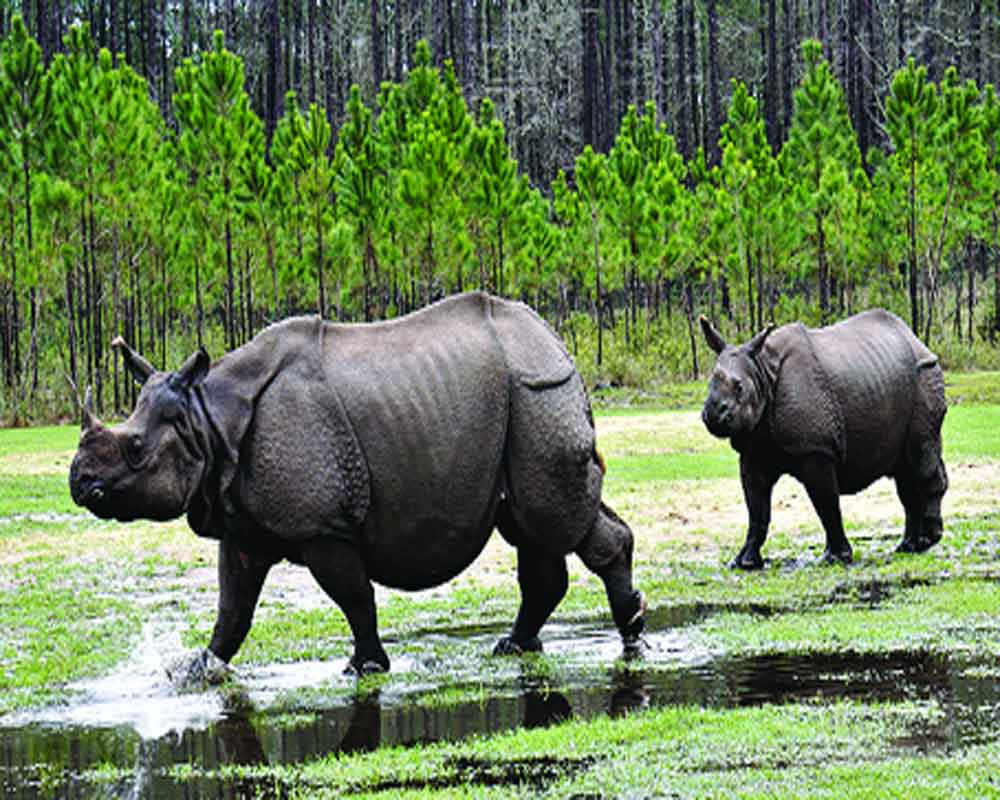2 countries add 516 greater one-horned rhinos in three years
Better law enforcement and conservation measures, aided by coronavirus-induced lockdowns and restrictions for a couple of months, have led to the number of greater one-horned rhinos in India and Nepal increasing from an estimated 3,588 in 2018 to 4,014 at the end of 2021.
Prepared for the 19th meeting of the CoP to the Convention on International Trade in Endangered Species of Wild Fauna and Flora (CITES), which will be held in Panama in November this year, the report has lauded conservation efforts, including strengthened law enforcement in this regard in the two neighbouring countries which share borders ensuring free movement of the endangered wild species.
The report, however, found that 11 rhino poaching incidents were recorded in Asia (ten in India and one in Nepal) since the beginning of 2018, all of which involved greater one-horned rhinos.
Besides arresting 43 suspects linked to rhino poaching cases in three Provinces in the period from 2018 to April 2022, India also initiated DNA profiling of rhinos for a national database using samples from dead rhinos, the report said. It added that a RhODIS-type capacity, with an initial focus on improving crime scene investigation, including training and sample collection was developed. The RHODIS-India programme provided tamper-proof kits used for rhino crime investigations.
According to the report, India shared that surveys in 2022 confirm numbers in Assam are growing and had an estimated 2,885 individuals in four populations.
“India reported an increase of 235 rhinos from February 2018 when Assam had 2,650 individuals. Kaziranga National Park in Assam conserves the majority (81%) of India’s population, with numbers continuing to increase. Further, India re-established a population in Manas National Park which now has 40 greater one-horned rhino, with births offsetting earlier poaching losses. Since 2015, numbers in Uttar Pradesh have increased by six to 38.
“The new counts in West Bengal since the 2015 estimate of 255 noted that rhinos increased to 339 at March 2022. The last wild rhino translocation in Assam was in 2021, with a male and female moved to Manas National Park,” said the report about the conservation measures.
Overall, world over rhino poaching rates declined since 2018, and trade data suggested the lowest annual estimate of rhino horns entering illegal trade markets since 2013.
“The overall decline in poaching of rhinos is encouraging, yet this remains an acute threat to the survival of these iconic animals,” said Sam Ferreira, Scientific Officer with the IUCN SSC African Rhino Specialist Group, in a statement from the International Union for Conservation of Nature (IUCN).
“To support the growth of rhino numbers, it is essential to continue active population management and anti-poaching activities for all subspecies across different range states.” The report found that rhino poaching rates in Africa have continued to decline from a peak of 5.3 per cent of the total population in 2015 to 2.3 per cent in 2021.
At least 2,707 rhinos were poached across Africa between 2018 and 2021, accounting for both the white rhino (ceratotherium simum), which is vulnerable on the IUCN Red List of Threatened Species™, and the rarer critically endangered black rhino (diceros bicornis).
South Africa accounted for 90 per cent of all reported cases, predominantly affecting white rhinos in Kruger National Park, home to the world’s largest white rhino population, added the statement.
As a result, overall white rhino numbers on the continent have declined by almost 12 per cent (from 18,067 to 15,942 individuals) during this period, while populations of black rhino increased by just over 12 per cent (from 5,495 to 6,195 individuals). Overall, Africa’s rhino population declined around 1.6 per cent per year, from an estimated 23,562 individuals in 2018 to 22,137 at the end of 2021.
According to the report, global lockdowns and restrictions due to the Covid-19 pandemic saw several African countries experience dramatically reduced poaching rates in 2020 compared to previous years. South Africa lost 394 rhinos to poaching in 2020, while Kenya recorded no rhino poaching that year. However, as Covid-19 travel restrictions were lifted, some range states reported new increases in poaching activities - for example, South Africa reported 451 and Kenya six poached rhinos in 2021. However, these numbers are still significantly lower than during the peak in 2015, when South Africa alone lost 1,175 rhinos to poaching.
However, in 2019, before the Covid-19 outbreak, the reported seized weight of illegal rhino specimens reached its highest point of the decade, perhaps due to increased regulations and law enforcement efforts. While the range and consumer countries most affected by illegal trade remained the same as in previous reports, the lack of consistent reporting by some countries still limits the ability to better understand patterns of illegal trade in rhino horns, said the statement.


























